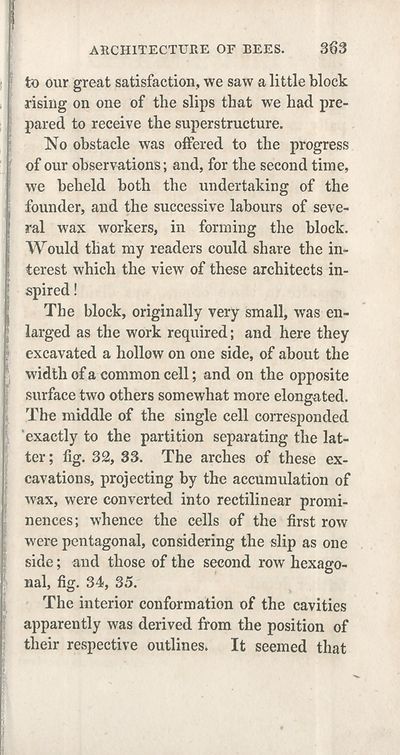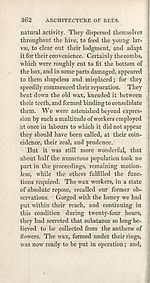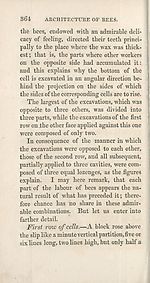Download files
Complete book:
Individual page:
Thumbnail gallery: Grid view | List view

ARCHITECTURE OF BEES. 363
to our great satisfaction, we saw a little block
rising on one of the slips that we had pre¬
pared to receive the superstructure.
No obstacle was offered to the progress
of our observations; and, for the second time,
we beheld both the undertaking of the
founder, and the successive labours of seve¬
ral wax workers, in forming the block.
Would that my readers could share the in¬
terest which the view of these architects in¬
spired !
The block, originally very small, was en¬
larged as the work required; and here they
excavated a hollow on one side, of about the
width of a common cell; and on the opposite
surface two others somewhat more elongated.
The middle of the single cell corresponded
exactly to the partition separating the lat¬
ter ; fig. 32, 33. The arches of these ex¬
cavations, projecting by the accumulation of
wax, were converted into rectilinear promi¬
nences; whence the cells of the first row
were pentagonal, considering the slip as one
side; and those of the second row hexago¬
nal, fig. 34, 35.
The interior conformation of the cavities
apparently was derived from the position of
their respective outlines. It seemed that
to our great satisfaction, we saw a little block
rising on one of the slips that we had pre¬
pared to receive the superstructure.
No obstacle was offered to the progress
of our observations; and, for the second time,
we beheld both the undertaking of the
founder, and the successive labours of seve¬
ral wax workers, in forming the block.
Would that my readers could share the in¬
terest which the view of these architects in¬
spired !
The block, originally very small, was en¬
larged as the work required; and here they
excavated a hollow on one side, of about the
width of a common cell; and on the opposite
surface two others somewhat more elongated.
The middle of the single cell corresponded
exactly to the partition separating the lat¬
ter ; fig. 32, 33. The arches of these ex¬
cavations, projecting by the accumulation of
wax, were converted into rectilinear promi¬
nences; whence the cells of the first row
were pentagonal, considering the slip as one
side; and those of the second row hexago¬
nal, fig. 34, 35.
The interior conformation of the cavities
apparently was derived from the position of
their respective outlines. It seemed that
Set display mode to:
![]() Universal Viewer |
Universal Viewer | ![]() Mirador |
Large image | Transcription
Mirador |
Large image | Transcription
| Antiquarian books of Scotland > Curiosities & wonders > New observations on the natural history of bees > (393) |
|---|
| Permanent URL | https://digital.nls.uk/128810583 |
|---|
| Description | Thousands of printed books from the Antiquarian Books of Scotland collection which dates from 1641 to the 1980s. The collection consists of 14,800 books which were published in Scotland or have a Scottish connection, e.g. through the author, printer or owner. Subjects covered include sport, education, diseases, adventure, occupations, Jacobites, politics and religion. Among the 29 languages represented are English, Gaelic, Italian, French, Russian and Swedish. |
|---|

